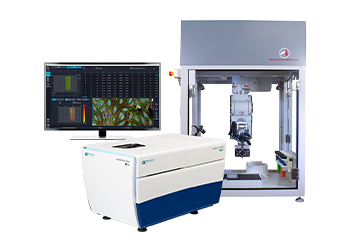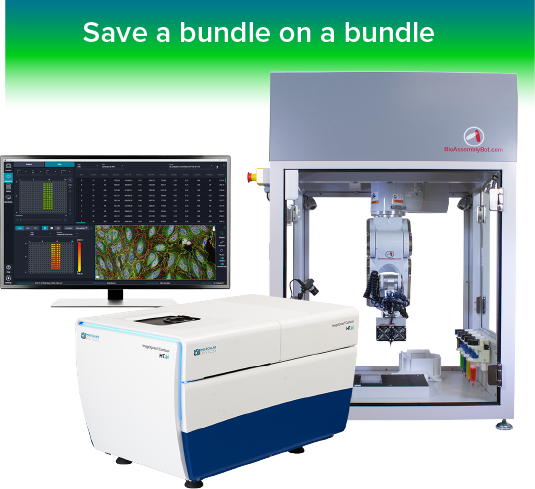Automated bioprinting solution for high-content screening with the BAB400 bioprinter for optimized 3D tissue and organoid workflow
BioAssemblyBot® 400 (BAB400) by Advanced Solutions is more than a bioprinter—the BAB400 is an intelligent robot with a 6-axis robotic arm that utilizes a wide range of interchangeable fabrication tools to reliably reproduce 3D model systems with increased throughput and precision, alleviating common concerns associated with manual workflows. Jointly developed by experts from both companies, the BAB 400 for Drug Discovery includes specific enhancements to its existing bioprinting platform to help life scientists overcome the challenges of reproducing consistent, complex organoid models at scale for drug development.
The BAB400 bioprinter integrates seamlessly with the ImageXpress® Confocal HT.ai High-Content Imaging System and IN Carta® Image Analysis Software for an integrated, optimized organoid workflow with automated passaging, cell culture monitoring, suspension dispensing, and 3D bioprinting of tissues and organoids.

Develop new drug targets
Consistently dispense, place, and print organoids for use in drug discovery with higher throughput vs. manual workflows. Test drug toxicity or efficacy on 3D models that are representative of native human tissues.

Improved viability of 3D cell cultures
Reliability and reproducibility of BAB allows for consistency in maintaining improved viability of organoids over time.

Enhanced flexibility with integrated workflows
BAB seamlessly integrates with high-content imagers for monitoring cell health or improved efficiency in end point assays.
Features

Extend human ability
The precision of the BAB400’s six-axis robotic arm exceeds human dexterity to bioprint, pick up biology, and complete complex assays while reducing human error, variability, and cost.

Automate with BioApps™
The user-friendly interface allows you to use existing protocols or customize your own.

Can I have a hand?
BAB swaps "hands" giving users the ability to 3D bioprint while controlling temperature, pressure, UV exposure, and more with the ever-growing catalog of tools.

Load in materials and go
Add in your biomaterials and press “go.” BAB will automate countless processes, including passaging cells, bioprinting, organoid dispensing, and more. Once these processes are complete, the BAB will notify you that the work is completed.
BioAssemblyBot 400 bioprinter seamlessly integrates with ImageXpress high-content screening system for an automated 3D biology workflow
Produce and maintain living tissues, organoids, and spheroids more consistently than ever before. Then analyze them without ever touching the well plate. In a fully automated enclosure, the BAB 400’s six-axis robotic arm uses a wide range of interchangeable ‘BAB hands’ to systematically reproduce organoids, while the ImageXpress Confocal HT.ai system informs the modeling and screening process with high-content cellular imaging information for increased precision, fast image acquisition, and multiplexing flexibility with high-performance lasers. The high-content screening system comes equipped with IN Carta Image Analysis Software, an AI/machine learning image analysis software to help researchers advance their phenotypic screening of complex 3D cell models.
Bundle your 3D biology workflow solution and save!
Optimal bundle of instruments provide an automated, end-to-end workflow solution for your 3D biology research.
- NEW! Assay-ready Organoids: Quickly scale up organoid expansion with solutions for the production of reproducible, assay-ready organoids
- NEW! BioAssemblyBot 400 Bioprinter: Multifunctional robot automates organoid seeding in Matrigel domes, feeding, monitoring, incubation, and screening
- ImageXpress Confocal HT.ai High-content Imaging System: Increase throughput and speed up acquisition times
- IN Carta Image Analysis Software: Leverage machine learning to improve the accuracy and robustness of high-content image analysis


